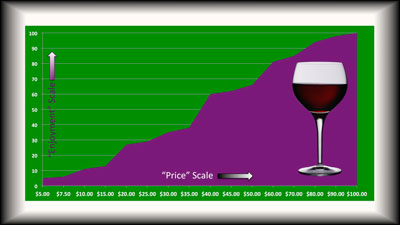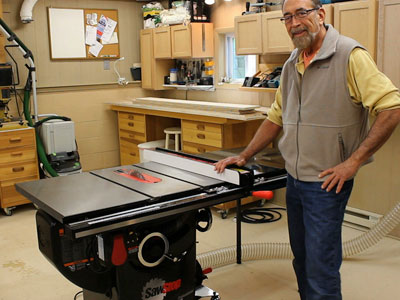
 by Steven D. Johnson
by Steven D. Johnson
Racine, Wisconsin
This month:
•
Of Wine & Table Saws (Not To Be Used Together!)
•
Mysterious Vanishing Clamps
•
The Internet Of Tools (Machinery & Tool Manufacturers Need To Embrace Technology)
•
Some Products We Woodworkers Want (Entrepreneur Alert)
Of Wine & Table Saws
Click on any picture to see a larger version.
I admit to being an oenophile. Get your minds out of the gutter… it means "a person who loves or is a connoisseur of wine"… I guess I'm a "lover," not so much a "connoisseur." But I have been to a lot of tastings, can usually identify the grape, the year, and the region, and can pass muster with most other amateur wine-lovers. A trained palette, careful note taking, and a bit of moxie helps.
I love wine for all the usual reasons, of course, but also for some not-so-common reasons. Wine, to me, is the penultimate expression of capitalism; there is a pureness to its price/value ratio. Wine is a pure expression of the intrinsic theory of value. Plainly, it is a product where you almost always get exactly what you pay for.
A $10 bottle of wine will pretty much always taste like a $10 bottle of wine. A $20 bottle will be significantly better. A $40 bottle will taste even better. And compare two different $80 bottles of wine, and though each will taste different, each will be "worth" $80 in the quaffing parameters that are important.

|
|
Figure 1 - With wine you almost always "get what you pay for."
|
Years of tasting and taking notes resulted in this chart of relative wine "enjoyment" scores.
The thing to note here is that from $15 to $20 per bottle, there is a pretty significant jump in quality. There are incremental increases from $25 to $30 to $35, but there is another pretty significant jump in taste and quality when you move from a $35 bottle to a $40 bottle, and another jump when moving from $50 to $60. It is democratic, capitalistic, fair, predictable and beautiful… you get what you pay for.
Fortunately, the price/value scale holds true with many other products. A $325 Lie-Nielsen No. 5 Jack Plane is going to work a lot better and last a lot longer than a $65 contractor grade No. 5. And while statements like this usually stir heated debate, a $675 Festool CT 36 E HEPA Dust Extractor works about $600-worth better than a $75 home-store shop vacuum… ask anyone who has one.
So it was this price/value optimistic (and some might say naïve) worldview that stopped me from buying a SawStop Tablesaw. My rationale was pretty simple:
The SawStop PCS with 3HP motor and 36" fence costs ~$2,900. The Powermatic PM2000 similarly spec'd costs ~$2,960. Likewise, a Delta 3HP Unisaw is over $3,000. I figured the SawStop blade brake safety mechanism has to add at least a few hundred dollars to the manufacturing cost, so how can a saw that is less expensive and includes a several-hundred-dollar safety mechanism be anywhere close to as good as the venerable Powermatic and the legendary Unisaw? The price/value equation just didn't add up in my "intrinsic theory of value."
Compounding the problem was that of the thousand reviews of the SawStop, about 99.999% of the reviewers got so "jazzed" with nicking the skin on a hot dog that they forgot to say whether or not the saw is really a good saw. After wasting more hours than I care to admit, I found only one reviewer that professed to focus only on the saw's operational capabilities, but then confessed that the unit was provided at no charge by SawStop for testing purposes. Sorry, you may be purer than snow and more honest than Abe, but when I find out you got the product for free, my trust in your objectivity is diminished.
Further compounding the problem was that I have been the fortunate owner of both a Powermatic and a Delta table saw, as well as a few other brands. I know first hand what an excellent table saw feels like, sounds like, and how it performs. I know their value. So how could SawStop, at slightly less money, but with an expensive safety feature added, possibly perform as well? The price/value equation seemed skewed and it had me stymied. As much as I wanted to replace my contractor-style table saw with a cabinet saw, I was locked in analysis paralysis.
Then one fine Sunday morning over breakfast my wife, who had seen a hot dog demonstration, out of the clear blue asked, "When are you going to get that new saw?" I regaled her with my price/value analysis, my consternation at no encompassing reviews to reference, my fear that I would have a very safe, but not very good saw for the price of a very good saw… and as her eyes started to glaze over, she interrupted and exclaimed, "Just get it so I don't have to hear about it anymore." I called Highland Woodworking on Monday. The saw arrived on Thursday.

|
Figure 2 - This is my "pleasantly surprised" look...
the SawStop is a very fine table saw.
|
And now my price/value life/world view is completely altered. I may never be the same. The SawStop is a fine piece of equipment. From the packaging to the assembly instructions, first class all the way. Fit and finish is beyond any stationary equipment that has graced my shop in many years. Controls and adjustments are solid, well thought out, and immaculately engineered. Vibration is non-existent. The saw is as accurate as any, the dust collection is superior, sound level is comparable to other units, and power is ample. If there were no blade brake safety mechanism and I was testing this saw side-by-side with a Powermatic and Delta, I would pick the SawStop as being equal in every important quality and performance parameter and slightly lower in cost. Throw in the flesh-sensing safety mechanism, and this saw represents the best overall value on the market today. In fact, even though a bunch of people are going to lambast me for this, SawStop should raise their prices.
As it is, I am now reexamining the economic principles upon which I have long relied. You do get what you pay for… and sometimes you can get a lot more. I now believe it is possible to find a $20 bottle of wine that tastes like a $40 bottle… or maybe even a $60 bottle… when I do, I will let you know.
By the way, I vowed I would not do "yet another" review of the SawStop table saw, and I won't. But I am building an outfeed table for it, and I made it a goal to use the SawStop for virtually every operation. Ripping, cross-cutting, mitering, even dados are being done on the SawStop, and I am learning a lot about the saw. You can follow my progress by clicking HERE. There are even a few "review-like" observations thrown in… I just couldn't resist.
(Page 1 of 4)
2
3
4
Next Page
If you're considering purchasing a SawStop Tablesaw,
PLEASE CLICK HERE to read more details about the saw.
Return to Wood News front page
